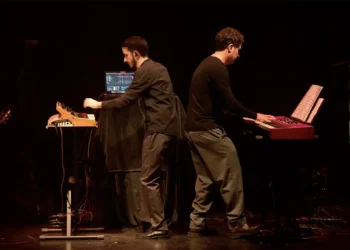|
‘CARMEN’ |
||
|
SPECIAL BIENAL DE FLAMENCO DE SEVILLA 2008 Text: Estela Zatania Dance: Sara Baras, Luís Ortega, José Serrano, Alicia Fernández, Ana González, Cecilia Gómez, Charo Pedraja, María Vega, Daniel Saltares, David Martín, David Nieto, José Galán, Raúl Fernández. Guitarra: José María Bandera, David Cerreduela, Mario Montoya, José Carlos Gómez. Cante: Miguel de la Tolea, Saúl Quiros, Brenda García. Música: Joan Valent, José María Bandera, David Cerraduela, José Carlos Gómez, Miguel de la Tolea, Saúl Quiros. Colaboración especial de Paco de Lucía y Javier Rubial. The large Maestranza theater packed to the rafters, with Manolo Sanlúcar debuting his new work at the Lope de Vega theater a few blocks away. The Duchess of Alba settled into her seat, and a mostly middle-aged audience that doesn’t look like your usual flamenco crowd. It must be the Sara Baras dance company. In other words, it’s Sara Baras. It’s been a long time since the young girl I saw triumph in a television contest twenty years ago ascended to world fame, and with the force of her name has been effortlessly filling the biggest theaters of the world. And rightly so. She is, above all else, a fine flamenco dancer; she belonged to us flamenco-followers long before belonging to the world, and we continue to enjoy her art. Sara Baras is responsible for the choreography, artistic direction, staging, lighting and wardrobe for this, and nearly all her shows, which is nothing less than astonishing, considering the high quality of the elements. Other companies that hire experts in each specialty, often don’t manage the level of Sara’s shows. She has an innate sense of theater and of elegance, passed through a Spanish and flamenco filter, and her clarity of vision of her shows is above that of most current works. Sara Baras conceives and implements: from her imagination to the stage, without interference. Taking into consideration this ability to precisely bring her ideas to the stage, we can now evaluate the merit of those ideas. In this version of Carmen, the “polkadots and tambourine” syndrome that makes young flamenco artists break out in hives, has been substituted by a wardrobe of basic black and electric red, in addition to shawls and fans, elements that any foreign audience can identify as Spanish. The libretto, in this work, as in all dance shows with a script, is purely circumstantial, a pretext to keep the casual spectator interested. This is an abstracted and modified version of a classic, and in my opinion it was a mistake to tamper with the original story. You take away the brawling women at the beginning, the arrest of the main character, her seduction of the soldier in order to flee from prison and the dramatic murder at the end, and it’s like a paella without rice: lots of the same ingredients, but a different dish entirely. In fact, not even with a magnifying glass can you find the original intent of Mérimée or Bizet, so we end up with a standard love triangle centered on a modern, middle-class woman who is neither bound by the restrictions of traditional Spanish Catholic society, nor suffers discrimination because of her low social status. The heroine of this work has more in common with the sophisticated girls who do makeovers in the cosmetics department of Bloomingdale’s. The myth of Carmen is employed by this box-office-savvy dancer to deploy a work that could have been titled “Passion, no thank you, I’m modern”. And that very insistence on modern-ness is precisely what subtracts strength from the story: without taboos, there’s no angst. The art of silence and show motion carried to the extreme. Shortage of cante. Visual austerity. Excellence in the details.
|



 XV BIENAL DE FLAMENCO DE SEVILLA
XV BIENAL DE FLAMENCO DE SEVILLA 




















